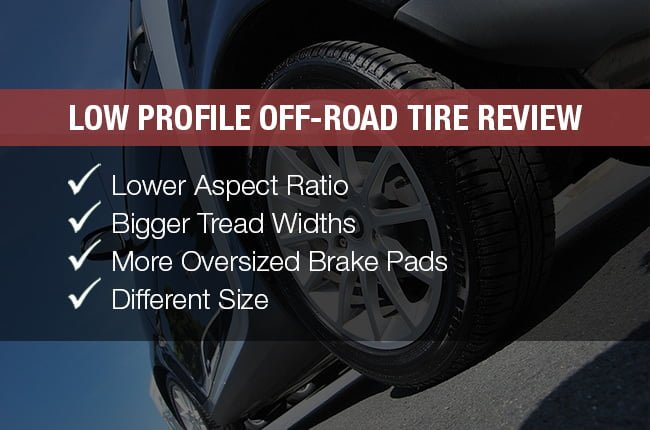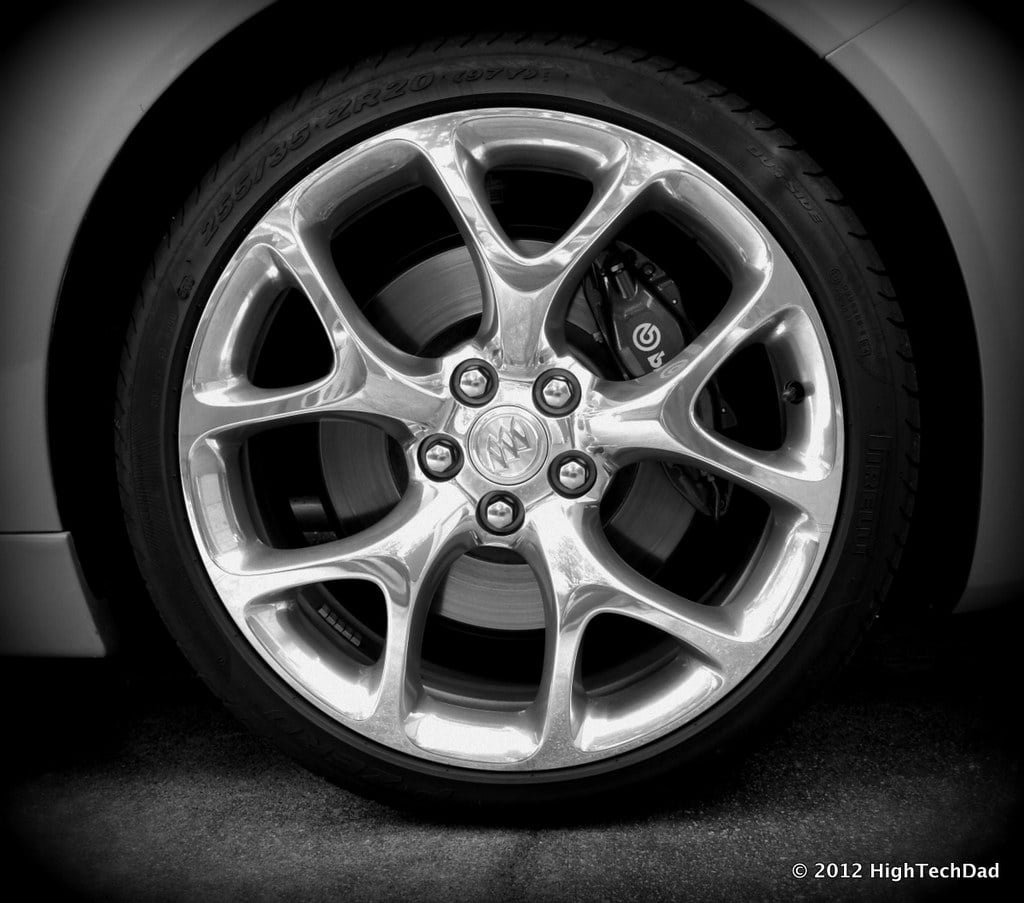A low-profile off-road tire is a tire that has a smaller aspect ratio compared to regular tires. They also have larger rims, bigger widths, and large grooves, which combine to give them excellent grip and stability on paved and unpaved roads. These tires are so popular that they are aesthetically pleasing, offer better steering control and better speed control since you can install more oversized brake pads. Usually, tires with an aspect ratio of less than 50 are considered low profile, and they come with a host of performance-enhancing benefits.

Features Of Low-profile Off-road Tires
Here are some common features of a low-profile off-road tire:
Lower aspect ratio
The first thing you will notice about a low-profile tire is the large wheel (rim size), which means the sidewall or aspect ratio (distance between the edge of the rim and the top of the tire is smaller than usual. Any tire with an aspect ratio of less than 50 is considered a low-profile tire from a broader perspective. This small amount of rubber between your vehicle and the road confers certain positive qualities to the tire, such as better grip, better steering control, and better corner maneuverability. However, it is not without its downsides as well. We will take a better look at these later.

Bigger tread widths
A common feature of this kind of tire is the width. Unlike standard tires, they have bigger widths and larger tread blocks, providing more surface contact with the road to improve traction and handleability.
More oversized brake pads
Another positive feature that comes with the large wheel size is that the brake pads are equally large. Larger brake pads provide more force and make it easier to control the vehicle’s speed.
Size
Low-profile tires, like any other tire, come in different sizes. The specific size will depend on the type of vehicle you use. It is advisable to contact your vehicle manufacturer or an expert and get the best low-profile tire size for your vehicle. When considering the right tire for off-road uses, essential factors to look out for are the aspect ratio and tread life expectancy. Although these tires have aspect ratios as low as 30 or 35 (considered ultra-low), this is not ideal for all applications. The reason is that a low aspect ratio could accelerate the rate of wear and reduce the life expectancy of the tire. The rate of wear is generally higher when using the tires off-road.
Types Of Low-profile Tires
All Season
As the name suggests, you can use these tires all season. Their ability to perform in both wet and dry conditions is attributed to the symmetrical tread patterns, rubber composition, and extra features like sips. Additionally, they come with more extensive groves than most other tires. These groves act as a self-cleansing mechanism that allows water and debris to move through quite quickly. The result is a tire that is long-lasting and delivers optimum performance all year round.
Winter
You can use winter low-profile tires for colder weather conditions when most tires would fail. They come with even larger groves than the all-season tires and may also be studded for better grip. A combination of soft rubber, large groves, and studs gives these tires an edge on icy weather conditions of about 7oC and below. However, these tires are noticeably noisier in exchange for their exceptional performance, especially at higher speeds.
Touring
Touring low-profile are similar to All-season tires but designed for more speed compared to the All-season tires. They also have an asymmetrical tread pattern, which provides better surface contact with the road. They provide comfort and stability, especially on rough roads, and are generally quieter than most other tires.
Summer
Low-profile summer tires are designed for excellent performance in dry road conditions. They have uniquely designed treads and are made with compounds that improve their speed, traction, and toughness. A common trait of these tires is that they are usually softer and more flexible than regular tires and may also come with fewer groves. These qualities improve the grip by increasing the friction between the tire and road surface.
High Profile vs. Low Profile Tires: Which makes them different?
Performance
Low-profile tires perform better than high-profile tires, which is why you can find them in racing and other performance vehicles. Their low aspect ratio gives better handling and turning capabilities, while the large brake pads mean more force is available to stop the vehicle. Additionally, the shorter sidewalls of low-profile tires make them more responsive, and the wider width provides grip on dry roads and corners. In general, they improve steering performance giving the driver more control over the vehicle.
Fuel Efficiency
In terms of fuel efficiency, low-profile tires have the edge here because the thin rubber between the wheels and the road means there is not much deformation or flexing. Their thin profile makes them better at conserving energy than high profile tires. Flexing and deformation absorb energy and lead to fuel inefficiency.
Technology
Low-profile tires come with a self-supporting system that allows them to run with lesser air than high-profile tires. They are designed to be effective even when completely deflated. This technology that makes this possible is called run-flat technology. Furthermore, it allows the vehicle to move at reduced speeds even when the tire has been punctured. Tires that incorporate this technology are called run-flat tires. They also have a reinforced sidewall that provides sufficient support in the event of a loss in air pressure.
Appearance
Most people prefer low-profile tires because they improve aesthetics and give the car a sporty look. They have bigger wheels and broader widths that make them aesthetically pleasing than high-profile tires. Other than the boost in performance, most users opt for low-profile tires just for their looks.
Famous Low Profile Brands
Although they are many manufacturers of low-profile tires, some brands are more popular. Michelin, Cooper, and Goodyear are among the popular low-profile tire manufacturers, and for good reasons. Here are three products from these companies which we will recommend.
Michelin Tires
Michelin is a French Tire manufacturer and one of the largest tire manufacturers in the world. The French company was founded in 1889 and has grown to be a multinational company with its headquarters in Clermont-Ferrand, France. The company is famous for its innovative technologies in tire manufacturing, fuel-efficient tires, top-tier manufacturing standards, and excellent warranty on some of its products.
Recommended Product – Michelin Pilot Sport PS2 Radial Tire
The Pilot Sport PS2 Radial tire is a low-profile summer tire for both dry and wet road conditions. It has a tread life of 20,000 miles, good traction, and produces less noise. It comes in different sizes and goes for about $552.99 for the R20 size. Note, the price will depend on the size of the tire.
Cooper Tires
Cooper tire and rubber company is an American tire manufacturing company based in Ohio. It was founded in 1914 and has grown and expanded into Canada, Europe, Asia, Mexico, and the Middle East. Cooper tire and rubber company is the 4th largest tire manufacturer in America and among the top 10 worldwide. Their products are affordable and safe. They also give treadwear warranties for up to 80,000 miles.
Recommended Product – Cooper Zeon All-Season Tire
The Cooper Zeon is an all-season low-profile tire for ultra-high performance in dry and wet conditions. Its asymmetrical tread pattern offers improved traction, grip in corners, and less noise. This tire features 3-D Micro-Gauge sipes that improve traction in slippery conditions like light snow for better handling capability. This feature makes the Cooper Zeon an excellent performer all year round. To purchase this on Amazon, you would need between $106 – $253, depending on the specs you want.
Goodyear Tires
Goodyear Tire and Rubber company is another American Tire manufacturing company based in Ohio. In 1898, the company produced tires for commercial trucks, light trucks, SUVs, race cars, etc. As of 2017, this company ranked among the top 4 tire manufacturing companies globally.
Recommended Product – Goodyear Eagle RS-A Radial Tire
The Goodyear Eagle RS-A Radial tire has an asymmetrical tread design that improves traction, cornering capability and produces less noise. It is an all-season tire, which means you can confidently use it in dry, wet, and snowy conditions. Depending on the specs you want, this tire goes for within $65 to $463 on Amazon.
Caution When Choosing Low Profile Tires

Low-profile tires combine excellent performance with great aesthetics. However, there are downsides to going so low, and we think it is important you know them. Here are some things you have to watch out for when choosing low-profile tires.
Tread Life
Low-profile tires are more prone to tread damage because they have a smaller aspect ratio. This means the amount of rubber or air cushion between the wheels and the road will be smaller, reducing the tire’s cushioning capability. Moreover, the wear rate of this tire is accelerated when used on rough or bumpy roads. Although this design improves grip and traction, the compromise is that you get to have a bumpier ride on rough roads and a higher wear rate. So it’s essential to know the tread life of the tire. Most manufacturers offer tread life warranties, and you can take advantage of these.
Weather requirement
If you plan to get a low-profile tire, then you have to be mindful of the weather conditions in which you will be using it. Similar to regular tires, low-profile tires can operate in specific weather conditions. Getting a summer tire for a snowy or icy road could prove fatal because critical features like sipes and studs make a winter tire different from a summer tire.
Noise
A possible downside of low-profile tires is that they are noisy due to the larger contact surface with the road by design. However, most manufacturers now implement designs like asymmetrical treads that produce less noise, and these are the ones you should go for.
Ride quality
Although these tires will perform well on paved and smooth roads, they generally offer a bumpier ride on rough or uneven roads. Tire cushioning or spring effect tends to be inversely proportional to the aspect ratio. This means that the smaller the tire profile, the lower its cushioning effect. Because of this, low-profile tire manufacturers try to achieve a balance between the perfect grip and ride comfort. So once again, you must look up with your manufacturer to know which tire will offer the best grip and comfort compromise for you.
Final Thoughts
Low-profile tires are great choices if you’re gunning for a combination of performance and aesthetics. Most users opt for these tires because they look good, and we agree, but don’t forget to watch out for some of the compromises that come with the look. If you live in an area with rough or bumpy roads, it is advisable to go for high-profile tires for more comfort. But if you do not bother about a little bumpy ride, then these tires will do just fine.
Read more: Mickey Thompson Baja STZ Tires Review



